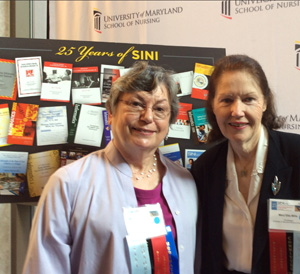SINI Looks to Future in Nursing Informatics
More than 300 nurse informaticians and health information technology professionals attended the University of Maryland School of Nursing's (UMSON) Summer Institute in Nursing Informatics (SINI). It was the 25th anniversary of the annual three-day conference, which gave participants an opportunity not only to reflect upon the past but to look forward.
Doug Fridsma, MD, PhD, FACP, FACMI, president and CEO of the American Medical Informatics Association, anticipated future trends in the rapidly developing field of informatics, which enhances the quality of patient care and outcomes through the development, implementation, and evaluation of information technology (IT). Delivered as the endnote on July 24, his address was titled: "Health IT in the Age of Precision Medicine: What's Next?"
The distinguished lecture on July 23 was delivered by professor Eliot Siegel, MD, FACR, FSIIM, of the University of Maryland School of Medicine, where he is vice chair of research informatics and associate vice chair of the Department of Diagnostic Radiology and Nuclear Medicine. Siegel's topic: "Watson and How Big Data are Changing the Future of Healthcare." Watson is the IBM computer that has turned to potential medical applications after outperforming human competitors on a nationally televised quiz show.
Who could have imagined when UMSON launched its pioneering national conference that by February 2011, a computer program (Watson) would best two top champions on the TV show, "Jeopardy!"? Shortly afterward, Siegel began leading a collaboration between IBM and the SOM that he describes as "Taking Watson to Medical School."
Watson can absorb huge databases and then mine that information quickly, and Siegel's vision is to make the University of Maryland, Baltimore a data repository for real-time, interactive research. Potential exists, for example, for cross-correlating genomic data from patients' tumors with MRI data.
Yet one of the biggest challenges is not computational but cultural. "In general, people don't share their clinical trial data once they've published and actually have incentives from the system not to," Siegel said. "Also, researchers don't get access to the valuable data available from clinical medical records."
That remains so despite what has been written on the need to share data, and the Institute of Medicine's recommendations.
Among other challenges is the nature of the electronic medical record, in which there may be hundreds of thousands of variables. To develop sound approaches for mining high-dimensional data, Siegel said, "We're going to have to rethink our current statistical tools, which are not designed for these types of data."
Beyond that, researchers and clinicians might benefit from access to raw data from clinical trials or, in the case of radiology, from the pixel (image) data itself rather than just the radiology report.
With this vast potential come caveats, he said, such as the need to scrutinize the "quality of the data in the database."
Fridsma, in looking forward during his remarks, urged the nursing informaticians in the audience to aim more for "orchestration than for command and control." Approaches must be suitable for rural communities and for academic medical centers

Co-chairs Judy Ozbolt, PhD, RN, FAAN, FACMI, FAIMBE, visiting professor at the University of Maryland School of Nursing (SON), left; and Mary Etta Mills, ScD, RN, NEA-BC, FAAN, CNE-BC, professor at the SON, oversee the 25th anniversary of the Summer Institute in Nursing Informatics (SINI).
in urban settings, he noted.
The keynote address, on July 22, was delivered by Suzanne Bakken, PhD, RN, FAAN, FACMI, alumni professor of nursing and professor of biomedial informatics at Columbia University. Speaking on the topic, "Informatics Support for the Underserved," she said: "Racial and ethnic minorities are less likely to be represented in some data sources such as biobanks and some types of social media."
She cautioned that special procedures are required for recruitment of racial and ethnic minorities and others typically under-represented in research. However, Bakken concluded that "informatics can promote the health of the underserved and advance health equity," among other things.
In a review of developments since 1991, the distinguished lecture on July 22 encompassed "25 years of SINI." Making the presentation were SINI 2015 co-chairs Judy Ozbolt, PhD, RN, FAAN, FACMI, FAIMBE, visiting professor at UMSON, and Mary Etta Mills, ScD, RN, NEA-BC, FAAN, professor at UMSON.
"SINI has evolved in concert with the development of communications and information technology and has both reflected and anticipated informatics innovations, enabling the use of information to improve patient care practice and health systems across the life span," says Mills.
In addition to lectures and peer-reviewed presentations highlighting advances in informatics, SINI 2015 featured concurrent sessions offered by expert faculty members from UMSON's No. 1 ranked nursing informatics master's specialty.
Awards were given to top-ranked poster and podium abstracts, and the conference included informatics exhibits and opportunities for networking, sightseeing, and celebration. During a 25th anniversary reception at Westminster Hall, 62 honorees were recognized for their seminal support of SINI over the years. Keynote lecturer Bakken and SINI co-chairs Mills and Ozbolt were among 17 honorees who have been involved with SINI since its inception.
”It has been a great pleasure to participate in the growth of nursing informatics and of SINI through the decades,” says Ozbolt. “Twenty-five years ago, there was just one nursing informatics graduate program in the world, and it was here at the University of Maryland School of Nursing. Now there are many throughout the world. For the quality of its presentations and for its networking opportunities, SINI continues to be unmatched as a source of professional development in nursing informatics.”



